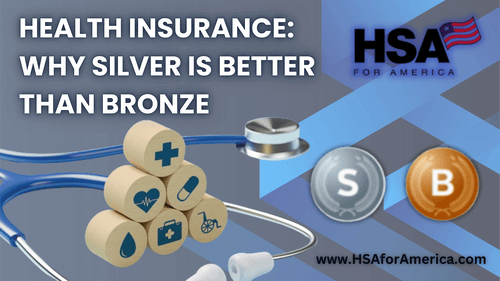Bronze Plans vs Silver Plans: When it comes to Affordable Care Act-qualified health insurance plans, “Silver” plans come with a higher sticker price than Bronze plans. But is the coverage worth paying for the higher-tier plans?

Bronze Plans vs Silver Plans
For most people, a Silver plan is preferable over a bronze plan – especially if you qualify for a subsidy under the ACA. And it may be worthwhile to consider purchasing a Gold- or Silver-tier plan, in certain situations.
This article explores the different Obamacare plan tiers, the features, benefits, and drawbacks of each, and how to decide which of these options is best for you.
We’ll also look at another outside-the-box alternative: health sharing. These non-insurance solutions can provide tremendous protection against the risk of high medical bills, but at a fraction of the cost of a traditional Obamacare health insurance policy.
Overview: The Obamacare Plan “Metallic” Tiers
First, let’s define our terms:ACA-qualified health insurance plans are categorized into tiers: Bronze, Silver, Gold, and Platinum. These tiers differ primarily in terms of premiums and cost-sharing. When you purchase an Obamacare plan through an agent or even directly over the Web, you will choose from one of these standard options:
The Four “Metallic” Plan Tiers
- Bronze plans generally have the lowest monthly premiums before subsidies but require higher out-of-pocket costs when you receive medical care.
- Silver plans are a middle ground, with moderate premiums and cost-sharing. Unlike Bronze-tier plans, Silver are eligible for cost-sharing reductions, which can lower out-of-pocket costs for individuals with lower incomes.
- Gold plans have higher premiums than Bronze or Silver plans but offer lower out-of-pocket costs when you need care.
- Platinum plans have the highest premiums but the lowest out-of-pocket costs. These plans are best suited for individuals who anticipate needing extensive medical care.
Compare Pricing on the Best Insurance Plans Available
Catastrophic Plans
Additionally, those age 30 or younger or who meet certain financial criteria can select a catastrophic plan. These plans have very high deductibles. But they pay 100% of claims above that point.
A catastrophic plan could be a good match if you are in good health, don’t expect to need much care in the next year, and you can easily afford the high deductibles associated with catastrophic-tier plans, and you won’t feel the need to delay or skip care because you can’t afford the deductible.
Catastrophic plans feature the lowest monthly premiums of all the plan tiers without accounting for subsidies and cost sharing. However, catastrophic plans also provide the most limited coverage, with the highest out-of-pocket costs, in most cases, in the event you do need medical.
Choosing the right plan tier depends on individual circumstances, including expected healthcare needs, your income level, and your household size.
The Obamacare “Metallic” Plan Tiers At a Glance
Benefits:
- Bronze: Lowest monthly premiums.
- Silver: Moderate premiums and cost-sharing; eligible for cost-sharing reductions.
- Gold: Lower out-of-pocket costs than Bronze or Silver.
- Platinum: Lowest out-of-pocket costs.
- Catastrophic: Lowest monthly premiums without subsidies; 100% coverage after deductible.
Advantages:
- Bronze: Good for healthy individuals who don’t anticipate needing much medical care.
- Silver: Good balance of premiums and out-of-pocket costs; cost-sharing reductions can make it more affordable for lower-income individuals.
- Gold: Good for individuals who anticipate needing significant medical care.
- Platinum: Good for individuals who anticipate needing extensive medical care and want the most financial protection.
- Catastrophic: Good for young adults or those with low incomes who want basic coverage and can afford high deductibles.
Disadvantages:
- Bronze: High out-of-pocket costs when you need care.
- Silver: Moderate premiums may still be a burden for some.
- Gold: High monthly premiums.
- Platinum: Highest monthly premiums.
- Catastrophic: Very high deductible; limited coverage before deductible is met.
What to Know About the Obamacare Bronze Plan
For those who don’t get a subsidy under the Affordable Care Act, the Bronze plan represents the lowest month-to-month cost of coverage available to the general public.
The Catastrophic plan is typically even cheaper, but it’s not available if you’re over 30, unless you qualify for one of several financial exemptions. So since a Catastrophic-only plan is not an option for many families.
The Bronze plan pays 60% of your eligible medical costs under the plan. You are responsible for the remaining 40%. However, the most you’ll have to pay out-of-pocket in any given year is $9,450 for a single individual, and $18,900 for a family, as of 2024. That is your “stop loss” number. Once you meet this number, your Bronze plan will normally pay 100% of eligible medical bills up to that number, which is adjusted each year to account for inflation.
What to Know About the Obamacare Silver Plan
Silver Plans are structurally similar to Bronze plans, but they take on a higher percentage of your medical bills when you need care.
When you are enrolled in a Silver Plan and need medical care, you’ll still need to cover your deductible. But the Silver plan will cover about 70% of your medical bills after your deductible, rather than the 60 percent covered by a Bronze plan.
The maximum out-of-pocket costs under both plans are the same however: $9,450 for a single individual, and $18,900 for a family plan.
Silver plans typically have higher premiums than a Bronze plan from the same carrier, all other things being equal. But that’s before the effects of the tax premium subsidy. If you qualify for a subsidy under the Affordable Care Act because of your income and household size, your premiums are effectively capped at your income.
If you get a subsidy, your actual out-of-pocket premiums for a Silver plan may actually be the same as they are for the lower-tier Bronze plan –– for more coverage.
Cost Sharing Benefits for Silver Plans Only
Silver plans have another significant advantage for lower- and moderate-income households:
Silver plans are eligible for cost-sharing subsidies. The other loans are not.
Cost sharing subsidies are a special type of Obamacare incentive that reduces your out-of-pocket expenses under a Silver plan. Essentially, these cost sharing benefits make your Silver plan perform more like a Gold or Platinum plan in the event you need medical care. They do this by reducing your out-of-pocket (OOP) responsibilities such as your deductible, coinsurance, and copays.
The catch: you only get this benefit if you join a Silver plan, and you only qualify if your income falls
falls under 250% of the federal poverty line for your household size.
Cost sharing reductions are calculated on a sliding scale based on your household income. The highest cost-sharing benefits go to those making 100% to 150% of the federal poverty line. But you can qualify for at least some cost-sharing reduction subsidy if your income is under 250% of FPL.
As of 2024, 250% of the poverty level equates to $36,450 for a single person and $75,000 for a family of four (note that the ACA uses poverty level numbers from the prior year to calculate the baseline, and that the poverty line is set higher inHawaii and Alaska, due to the high cost of living in those states.
Learn More: How Health Insurance Subsidies Work
The Value of Cost Sharing Benefits
If your modified adjusted gross income (MAGI) falls under the 250% of FPL threshold, and especially under the 200% of FPL threshold, the benefits can be significant, saving thousands of dollars in out of pocket costs in the event you need care.
Remember that in 2024, the maximum out-of-pocket cost for all metallic Obamacare plan tiers is $9,450 for an individual plan, and $18,900 for family plans. But if your MAGI is below 200% of FPL, your maximum out of pocket costs are effectively slashed by two thirds: down to $3,150 for a single individual, and $6,300 for a family.
If you choose the Bronze plan instead, thinking you will save money in premiums, you’ll still face up to $9,450 in out of pocket costs as an individual, and up to $18,900 for a family plan.
Essentially, if you qualify for cost sharing reductions, and you don’t choose the Silver plan, you are making a very big bet that you won’t need substantial medical care this year. And that’s a bet you may not be able to afford to lose.
In fact, few people with incomes below 200% or 250% below the federal poverty line can afford to simply write a check for their maximum out-of-pocket loss. An estimated 44% of American households cannot afford a $1,000 emergency without taking on more debt, let alone a $10,000, $15,000, or $18,900 emergency. This is likely especially true if you’ve got a family to support.
If you qualify for an Obamacare premium tax subsidy, and your income falls below 250% of the poverty line for your household size, a Silver Plan is probably the vastly superior choice compared to the Bronze plan.
Who Should Choose a Bronze Plan?
Bronze plans may be most suitable for you if you don’t qualify for a premium tax subsidy under the Affordable Care Act, and your household income doesn’t qualify you for cost sharing reductions associated with Silver plans.
If both criteria apply to you, you might consider a Bronze plan if you have some savings or a decent income, you can absorb a higher percentage of the cost of your health care, and you want to focus your coverage on major and catastrophic medical events, and pay the least possible premium each month.
It may not be suitable for you if the high deductibles and out-of-pocket costs would require you to skip or delay medical care you or someone in your family needs.
Who Should Choose a Silver Plan?
Silver tier plans represent a great balance of plan benefits and premium costs.
If you qualify for a significant ACA subsidy and your income falls below 250% of the federal poverty line, you are almost certainly better off with a Silver plan compared to a Bronze plan.
Since about 80% of U.S. households who don’t get an employer sponsored health plan from work qualify for at least some premium subsidy, the vast majority of households are better served by a Silver plan than a Bronze plan.
If your income is too high for a subsidy and much too high for a cost sharing subsidy, and you’re in very good health and don’t expect to need healthcare over the next year, then a Bronze plan may be indicated.
If you want to save even more money, you should consider a health sharing plan.
Who Should Choose a Gold or Platinum Plan?
Gold and Platinum plans are designed more for those who have significant health care needs and who are likely to need care within the next year.
These plans are pricey: they have the highest premiums of all the metal tiers. But deductibles for Gold plans are low, and deductibles for Platinum plans are very low.
These plans are good if you have pre-existing conditions or need ongoing healthcare. The higher premiums are balanced out by the lower out-of-pocket costs, lower variance in out-of-pocket costs, and more predictability.
Who Should Choose a Health Sharing Plan Instead of Insurance?
If you don’t qualify for a premium subsidy or cost sharing reductions because your income level is too high, given your household size, and you’re in good health with no significant preexisting conditions, you should consider a health sharing plan.
These are non-insurance alternatives that help you manage the risk of unexpectedly high medical bills. They are rapidly growing in popularity, and cost just a fraction of what you would pay for an unsubsidized ACA policy. 50% savings for unsubsidized households are not uncommon.
Because they aren’t insurance policies, they aren’t required to share costs for preexisting conditions right away. And they may have more limited mental health or prescription drug benefits compared to full-fledged ACA Marketplace policies.
Learn More: All About Health Sharing Plans
Compare Pricing on the Best HealthShare Plans Available
Bronze Plans vs Silver Plans Conclusion
Yes, there’s a lot of information to take in.
But it doesn’t have to be stressful or complicated, nor even time consuming. To find the best plan for your individual situation, help is only a few clicks away. All you need to do is make an appointment with one of our expert Personal Benefits Managers.
They’ve already done all the homework. They know what questions to ask you to help you narrow things down to just a few options based on your budget, medical situation, family size, and available subsidies and incentives.
HSA for America is among just a handful of health benefits firms that can talk to you about all your options, whether it’s a traditional health insurance plan, a subsidized Silver plan with cost sharing reduction benefits, a money-saving health sharing plan. Together, we’ll get you connected with a quality health plan that suits your needs that you can actually afford.
For Further Reading:

Hi! I’m Misty Berryman, and I’m one of your Personal Benefits Managers. I like working with HSA for America because we’re creating solutions to healthcare problems. Our focus on money-saving alternatives like HSA plans and health sharing programs, and the variety of health share programs we offer, are what set us apart. Read more about me on my Bio page.


